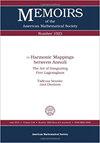de Sitter空间上的正则化模型
IF 2.4
4区 数学
Q1 MATHEMATICS
引用次数: 2
摘要
1975年,Figari、Høegh Krohn和Nappi在de Sitter空间上构造了P(φ)2{\mathscr P}(\varphi)_2模型。在这里,我们用新的结果来补充他们的工作,这些结果将这个模型与数学的各个领域联系起来。特别地,i.)我们讨论了de Sitter空间的因果结构和洛伦兹群的诱导表示。我们证明了主级数和补级数的SO 0(1,2)SO_0(1,2)的UIR可以在函数支持于柯西曲面的Hilbert空间上表示。我们描述了自由经典动力系统的协变和正则形式,并提出了Kay(1985)意义上的相关量子单粒子KMS结构。此外,我们讨论了单粒子波函数的局部化性质,以及这些性质是如何被局部可观察性的代数继承的。ii。)我们描述了与楔形代数相关的模对象(在富田-竹崎理论的意义上)与洛伦兹群的表示之间的关系。我们将SO(1,2)的表示与S O(3)SO(3)在欧氏球面上的酉表示联系起来,并讨论了P(φ)2{\mathscr P}(\varphi)_2相互作用如何用欧氏-Fock空间中的旋转不变向量表示。我们提出了一个新的Osterwalder-Schrader重建定理,该定理表明在de Sitter空间上不存在物理红外问题。如Figari、Høegh Krohn和Nappi(1975)所示,紫外线问题就像在平坦的Minkowski空间上一样得到了解决。我们陈述了P(φ)2{\mathscr P}(\varphi)_2模型的Haag–Kastler公理,并解释了相互作用量子场论的提升和旋转的发生器是如何由应力-能量张量产生的。最后,我们证明了相互作用量子场满足协变形式的运动方程。总之,我们认为de Sitter P(φ)2{\mathscr P}(\varphi)_2模型是最简单、最明确的相对论量子场论,它满足了协变、粒子产生、稳定性和有限传播速度等基本期望。本文章由计算机程序翻译,如有差异,请以英文原文为准。
The 𝒫(𝜑)₂ Model on de Sitter Space
In 1975 Figari, Høegh-Krohn and Nappi constructed the
P
(
φ
)
2
{\mathscr P}(\varphi )_2
model on the de Sitter space. Here we complement their work with new results, which connect this model to various areas of mathematics. In particular, i.) we discuss the causal structure of de Sitter space and the induces representations of the Lorentz group. We show that the UIRs of
S
O
0
(
1
,
2
)
SO_0(1,2)
for both the principal and the complementary series can be formulated on Hilbert spaces whose functions are supported on a Cauchy surface. We describe the free classical dynamical system in both its covariant and canonical form, and present the associated quantum one-particle KMS structures in the sense of Kay (1985). Furthermore, we discuss the localisation properties of one-particle wave functions and how these properties are inherited by the algebras of local observables.
ii.) we describe the relations between the modular objects (in the sense of Tomita-Takesaki theory) associated to wedge algebras and the representations of the Lorentz group. We connect the representations of SO(1,2) to unitary representations of
S
O
(
3
)
SO(3)
on the Euclidean sphere, and discuss how the
P
(
φ
)
2
{\mathscr P}(\varphi )_2
interaction can be represented by a rotation invariant vector in the Euclidean Fock space. We present a novel Osterwalder-Schrader reconstruction theorem, which shows that physical infrared problems are absent on de Sitter space. As shown in Figari, Høegh-Krohn, and Nappi (1975), the ultraviolet problems are resolved just like on flat Minkowski space. We state the Haag–Kastler axioms for the
P
(
φ
)
2
{\mathscr P}(\varphi )_2
model and we explain how the generators of the boosts and the rotations for the interacting quantum field theory arise from the stress-energy tensor. Finally, we show that the interacting quantum fields satisfy the equations of motion in their covariant form. In summary, we argue that the de Sitter
P
(
φ
)
2
{\mathscr P}(\varphi )_2
model is the simplest and most explicit relativistic quantum field theory, which satisfies basic expectations, like covariance, particle creation, stability and finite speed of propagation.
求助全文
通过发布文献求助,成功后即可免费获取论文全文。
去求助
来源期刊
CiteScore
3.50
自引率
5.30%
发文量
39
审稿时长
>12 weeks
期刊介绍:
Memoirs of the American Mathematical Society is devoted to the publication of research in all areas of pure and applied mathematics. The Memoirs is designed particularly to publish long papers or groups of cognate papers in book form, and is under the supervision of the Editorial Committee of the AMS journal Transactions of the AMS. To be accepted by the editorial board, manuscripts must be correct, new, and significant. Further, they must be well written and of interest to a substantial number of mathematicians.

 求助内容:
求助内容: 应助结果提醒方式:
应助结果提醒方式:


